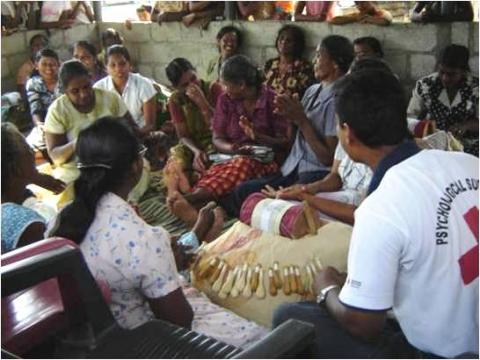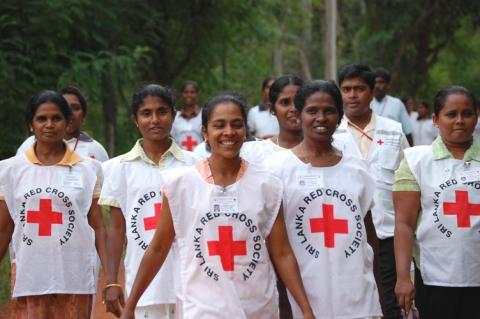Gender perspectives in disaster recovery

The following story was written by Lena Kang, Knowledge Management Intern, GDPC, based off an interview with Anjana Dayal de Prewitt, Senior Advisor, Community Mobilization at the American Red Cross.
Women and resilience
Bringing in high-level knowledge, technological know-how, and years of experience into long-term development initiatives, conflict zones, and disaster recovery is risky and insufficient if it lacks the proper foundations within ground-level solutions. In the context of recovery and resilience building in post-disaster settings, Anjana Dayal de Prewitt, Senior Advisor of Community Mobilization at the American Red Cross (ARC), states that “implementing and designing an appropriate and effective response is really about asking the right questions.” And in targeting those questions to the right people, notably women. In fast-paced disaster settings, response teams must tread carefully and appropriately, lest survivors’ emotional recovery become overlooked or compromised.
From her 12 years of experience in disaster and conflict settings, Anjana has witnessed the long reach that women have in impacting those around them. Women have both the traditional nurturing responsibilities and informal power that have the potential to affect change within their families, neighborhoods, and community structures. From her years of field experience in conflict and disaster settings, including Sri Lanka, Maldives, and India, Anjana finds women to be an under-capitalized asset and the key to resilience-building in disaster recovery.
Lace-Making Initiative, Sri Lanka
After the 2004 tsunami in Sri Lanka, Anjana served as the Country Lead Manager for the Psychosocial Support Program of the ARC. In the aftermath, Anjana met with women in states of trauma, shock, and acute stress. These women who once lived communally – celebrating, grieving, and sharing life together – now found themselves isolated and scattered throughout different transitional camps for internally displaced people. Through their interactions with the women, the ARC/Sri Lanka Red Cross (SLRC) understood the need to rebuild and restore the women’s sense of place. They also understood that such an initiative needed to arise from the community, through their own definition and articulation. In this case, an elderly woman and long-time member of her community proposed starting a women’s lace-making group. As part of her contribution, she would teach the skills to other women and reach out to various leaders for a physical gathering space. After the community secured a shed from the village’s fisherman community, the ARC/SLRC provided in-kind donations with affordable lace-making machines.

Anjana recalls that during the initial gatherings, lace-making lingered more in the background as the women shared, grieved, and laughed together. Eventually, they started making laces and selling them in the markets for profit. This initiative, supported by the ARC/SLRC, reflects the positive impact of implementing community-based projects through local solutions. The Red Cross Red Crescent (RCRC) societies recognize the importance of participatory and inclusive engagement in disaster recovery and psychosocial support programs that build on community-based and self-help initiatives. This collective enterprise also reflects the role that women play as powerful agents in producing social cohesion within their own communities.
Learning from the ground

When policies and knowledge run solely in the top-down direction from national headquarters to local branches to communities, we run the costly risk of missing out on the traditional knowledge and wisdom of the local branches and communities. In Anjana’s words, “we often forget that they have survived for years and years, long before formal trainings and manuals were produced.” Such perspectives often get lost within large humanitarian and development institutions with historically deep currents of prescriptive practices, hierarchical traditions, and a training-oriented approach. However, organizations that recognize and can effectively capitalize on local assets, wisdom, and resources find that the impact and reach of influence surrounding their efforts go much further. Anjana states that turning trainings into interactive workshops where there is genuine shared learning dialogue requires “integrating historical perspectives into our work and hearing how communities have learned to survive and recover.”
Leading Resilient Development: Grassroots Women’s Priorities, Practices and Innovations, a joint publication by UNDP, Groots International, and Northumbria University, provides insights and recommendations for how to understand and mobilize women “as leaders and active agents of strategies that advance disaster risk reduction and long-term resilience.” The report’s case studies illustrate the innovative ways in which local women in disaster-stricken regions have demonstrated leadership to secure resources and strengthen communities.
“Active engagement in community problem-solving enables grassroots women to undertake public decision-making roles. These public roles reposition grassroots women in the eyes of their families, communities and decision-making bodies. This in turn enables grassroots women to claim power and resources that contribute not only to building resilient communities, but also to sustaining their involvement in long-term development” (23-24).
By active listening, we find rich opportunities for learning and improving our own strategies. By seeking inclusive solutions, involving local branches, and engaging with community leaders, the RCRC societies work to tailor approaches that best fit the needs of targeted communities, in both disaster recovery and long-term development.
Lessons Learned :
- Asking the right questions is key. The most effective solutions arise from engaging with community members and listening to their needs. Understanding the needs within the local context serves as the impetus for developing and asking the right questions.
- Women are influential agents for building resilience. Women’s traditional nurturing responsibilities and informal influences of power are vital assets for effecting change and should be capitalized more robustly.
- Communities offer rich and important lessons for national society partners and headquarters. Local branches and communities have much to offer in wisdom, knowledge, resources, and assets, which have endured and stood the test of recurring natural hazards.
Supporting Materials :




